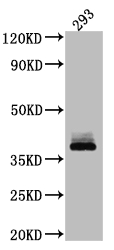To create a recombinant monoclonal antibody for DKK1, the DKK1 monoclonal antibody is harvested and its gene is sequenced. A DKK1 monoclonal antibody gene-carrying vector is constructed, and the recombined vector is transfected into a host cell line for culture. Human DKK1-synthesized peptide is used as the immunogen in the production of the DKK1 monoclonal antibody. The resulting DKK1 recombinant monoclonal antibody is then purified using affinity chromatography and tested for specificity using ELISA and WB applications. It only recognizes human DKK1 protein.
The DKK1 protein is a secreted protein that plays a role in embryonic development, tissue homeostasis, and disease. Its primary function is as an inhibitor of the Wnt signaling pathway, which is involved in cell proliferation, differentiation, and survival. DKK1 does this by binding to the Wnt co-receptor LRP5/6 and blocking its interaction with the Wnt ligand, which is required for activation of the Wnt pathway. As a result, DKK1 suppresses the transcription of Wnt target genes and influences many cellular processes such as embryonic development, bone formation, tissue regeneration, tumorigenesis, and others. Additionally, DKK1 has been implicated in several human diseases, including cancer, osteoporosis, Alzheimer's disease, and schizophrenia.






